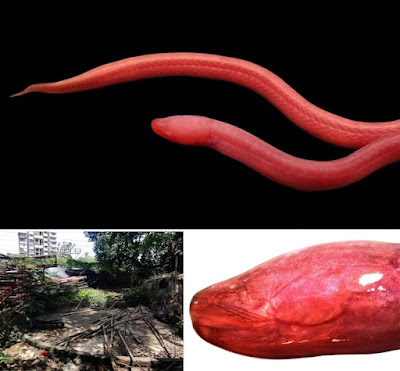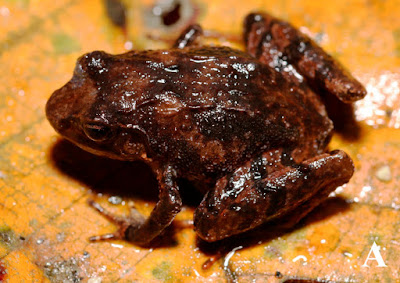[Most Recent Entries] [Calendar View]
Wednesday, June 1st, 2022
| Time | Event | ||
| 4:08a | [Ichthyology • 2021] Rakthamichthys mumba • A New Species of Hypogean Eel (Synbranchiformes: Synbranchidae) from Mumbai, Maharashtra, India
Rakthamichthys mumba a new species of synbranchid, hypogean, eel is described from Mumbai City, Maharashtra, India, based on morphological and genetic analysis. It differs from all other species of the genus Rakthamichthys by a combination of characters viz., absence of eyes, jaws equal in forward extent, gill aperture crescentric shaped, cephalic-lateralis system distinct with prominent cephalic pores and a vertebral count of 164 (80-83 preanal + 81-84 caudal vertebrae). The new species differs from a pair-wise sequence of 21.6-22.8% in the COI gene sequence from other members of the genus Rakthamichthys. Jayasimhan Praveenraj, Tejas Thackeray, Anil Mohapatra and Annam Pavan-Kumar. 2021. Rakthamichthys mumba, A New Species of Hypogean Eel (Teleostei: Synbranchidae) from Mumbai, Maharashtra, India. Aqua. 50(3); doi.org/10.23788/IEF-1163 instagram.com/p/CUYpWRlI-vJ aqua-aquapress.com/product/aqua-273_rakthamichthys-mumba | ||
| 8:58a | [Herpetology • 2019] Liurana vallecula • A New Species of the Endemic Himalayan Genus Liurana (Anura: Ceratobatrachidae) from southeastern Tibet, China, with Comments on the Distribution, Reproductive Biology, and Conservation of the Genus
ABSTRACT A new species of the genus Liurana Dubois, 1986 is described from Medog County, Tibet, China, based on morphological and molecular data. The new species can be differentiated from all other congeners by the following combination of characters: (1) head wider than long; (2) tympanum distinct and large; (3) hindlimb long, tibiotarsal articulation beyond tip of snout when adpressed; (4) belly with flat tubercles, cloacal region with small tubercles; (5) transverse bands distinctly on dorsal limbs, four bands on thigh and three on tibia; and, (6) dark brown marbled patterns or speckles on white belly. Here, we also discuss the distribution pattern of Liurana in the East Himalaya region, the role of the Yarlung Tsangpo River in the speciation and genetic isolation of congeners, the direct developmental mode of reproduction, and the two different ecotypes of the genus. Lastly, we provide conservation recommendations for the genus in southeastern Tibet. Keywords: Advertisement call; Biogeography; Ecology; Natural history; Tibet; Taxonomy Diagnosis: Liurana vallecula sp. nov. is assigned to the genus Liurana by its phylogenetic position and the following morphological characters: (1) body size small (SVL 14.6–20.4 mm, n=2); (2) tips of fingers and toes not expanded, (3) grooves absent on tips of fingers and toes; (4) webbing absent on all digits; (5) metacarpal tubercles and metatarsal tubercles absent; (6) tarsal fold absent; and (7) vocal sac and vocal sac openings absent. Ecological and natural history notes: Liurana vallecula sp. nov. is a terrestrial, leaf-litter specialist, inhabiting the forest floor of tropical broad-leaf forest at low elevations (below 1 000 m a.s.l.) near Yarlung Zangbo River and its immediate tributaries. The female holotype had about five immature eggs in the left ovary, which were well developed and relatively large. Distribution: Currently the new species is known only from the type localities of Xirang and Maniweng of Beibeng, Medog County, Nyingchi Prefecture, Tibet, China. The new species likely inhabits other nearby regions in southern Tibet (see Discussion below). Etymology: The specific epithet of the new species, “vallecula” means “valley inhabitor”, in reference to the habitat of this species in the lower river valley of Yarlung Zangbo Grand Canyon. We suggest Valley Papilla-tongued Frog as its English common name and He Gu She Tu Wa (河谷舌突蛙) as its Chinese common name. Ke Jiang, Kai Wang, Yu-Fan Wang, Cheng Li and Jing Che. 2019. A New Species of the Endemic Himalayan Genus Liurana (Anura, Ceratobatrachidae) from southeastern Tibet, China, with Comments on the Distribution, Reproductive Biology, and Conservation of the Genus. Zoological Research. 40(3); 175-184. DOI: 10.24272/j.issn.2095-8137.2019.025 New Tibertan Species of Genus Liurana (Anura, Ceratobatrachidae) Discovered | ||
| 3:53p | [Paleontology • 2022] Chemnitzion richteri • A New Basal Zatracheid Temnospondyl from the early Permian Chemnitz Fossil Lagerstätte, central-east Germany
Abstract A new zatracheid temnospondyl adds to the fossil-rich T0 assemblage of the Chemnitz Fossil Lagerstätte (Chemnitz Basin, Sakmarian–Artinskian transition). The skeleton was found in basal air-fall tuffs of the Zeisigwald Tuff (Leukersdorf Formation) and consists of the almost complete skull roof in dorsal view, parts of the occiput, fore and hind limbs, numerous presacral vertebrae and ribs, parts of the pelvic girdle and ventral scales. The new taxon Chemnitzion richteri gen. nov. et sp. nov. is proposed due to the following autapomorphic characters: (1) postorbital skull very short, about five times shorter than the preorbital skull; (2) elongate and robust hindlimbs, with femur length reaching almost half of the skull length. A phylogenetic analysis finds the new taxon at the base of a monophyletic Zatracheidae, forming a trichotomy with Acanthostomatops vorax and the more derived zatracheids [Zatrachys serratus + (Dasyceps bucklandi + D. microphthalmus)]. The animal was part of a diverse trophic web of plants, animals and microorganisms. Various vertebrates, arthropods and gastropods constituted a vital community that lived in a dense, seasonally influenced forest habitat dominated by tree-sized ferns, calamitaleans, medullosans and cordaitaleans. The temnospondyl’s death and taphonomic background is closely related to the ash-cloud deposition following a phreatoplinian eruption. The following massive pyroclastic flow finally entombed the moist forest and intensively heated all enclosed organic remnants. Keywords: Terrestriality, Chemnitzion richteri gen. nov. et sp. nov., Zatracheidae, Skull roof sculpture, Powerful hind limb, Cisuralian, Volcanic taphonomy Systematic palaeontology Order Temnospondyli von Zittel, 1888 Family Zatracheidae Cope, 1882 Genus Chemnitzion gen. nov. Etymology. The genus name aims to dignify the find locality, the city of Chemnitz—European Capital of Culture 2025. Chemnitzion richteri gen. nov. et sp. nov. Etymology In honour of Mr Fred Richter, dedicated fossil collector for many decades and chairman of the friend’s circle board of the Museum für Naturkunde Chemnitz. Locality and horizon. Chemnitz-Hilbersdorf excavation, Frankenberger Straße, central-east Germany; basal ash-tuff unit S5 of the Zeisigwald Tuff, Leukersdorf Formation, lower Rotliegend (Sakmarian–Artinskian transition, Cisuralian), Chemnitz Basin. Ralf Werneburg, Florian Witzmann, Joerg W. Schneider and Ronny Rößler. 2022. A New Basal Zatracheid Temnospondyl from the early Permian Chemnitz Fossil Lagerstätte, central-east Germany. PalZ. DOI: 10.1007/s12542-022-00624-8 |
| << Previous Day |
2022/06/01 [Calendar] |
Next Day >> |














